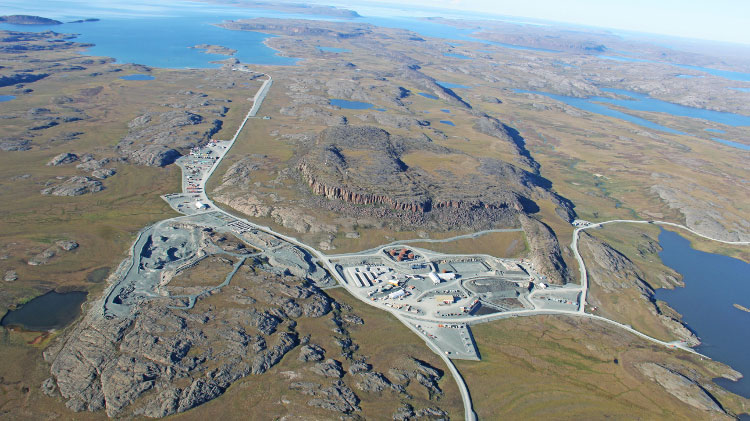The Flin Flon mill and crushing plant (CIM Bulletin, 1962).
The mining city of Flin Flon is located in northwest Manitoba, approximately 800 kilometres north of Winnipeg, and partly extends into Saskatchewan. Tom Creighton, an experienced prospector and trapper, discovered significant copper, gold, zinc, silver and lead deposits in the Flin Flon area in 1914 and named the site ‘Flin Flon’ after Josiah Flintabbatey Flonatin, a character who explores a bottomless lake by submarine in the 1905 novel The Sunless City, by J. E. Preston Muddock.
Creighton and his associates staked the first claims in August 1915. The property was optioned to Hayden Stone & Company, which started a drill campaign in spring 1916, completing more than 7,500 feet of diamond drilling and spending over $50,000 before abandoning the option due to the complex ore being lower grade than expected.
The property lay idle until 1925. “Not on account of a lack of tonnage of ore,” wrote W.A. Green (CIM Bulletin, 1930), “but because the ore body consists of a low-grade complex ore containing gold, silver, copper, zinc, and lead, for which no satisfactory method of treatment had at that time been worked out.”
In 1925, the site was brought to the attention of R.H. Channing, Jr., who was in charge of the mining interests of the American businessman Harry Payne Whitney. “Among Mr. Whitney’s varied mining interests was a company called Complex Ores Recoveries Company,” wrote R.E. Phelan (CIM Bulletin, 1935). “This company owned patents for the treatment of ‘complex’ ores, so that, when the analysis of the Flin Flon ore body was studied, it seemed that the company’s process might be applied to the treatment of the ore and thus make it the basis of a commercial operation.”
Flotation testing began at Complex Ores Recoveries’ Denver laboratory in March 1926, according to S.P. Lowe (CIM Bulletin, 1930). “On August 1st, 1926, it was decided to instal a 25-ton flotation plant at the mine, with a 10-ton cyanide plant for treating the flotation tailings,” he wrote. “The first ore was crushed on March 5th, 1927.” Later that year, the Hudson Bay Mining and Smelting Company (HBMS) was incorporated.
Challenges
Easier access to the site was also crucial to building a successful mining operation. “Prior to the advent of the railway, the property was quite isolated,” wrote Green (1930). “The summer route was over a course of some 175 miles, consisting of a 125-mile boat trip from The Pas, first up the Saskatchewan River, then across Cumberland and Sturgeon Lakes to Sturgeon Landing. From Sturgeon Landing, a 16-mile portage was necessary to Camp 2 on Lake Athapapaskow. From Camp 2 the route consisted of a canoe trip of 32 miles across Lake Athapapaskow, up the northwest arm of Schist Lake, then up Ross Creek to the company’s docks, and finally a 2-mile walk to the property.”
He noted that the winter route was just under 100 miles in length, “the difference being due to the fact that a more direct route could be followed over the frozen lakes.”
In 1925, the group had sought government help to connect the site to the Hudson Bay branch of the Canadian National Railways, which was more than 90 miles away. “The Premier had a charter issued for the Manitoba Northern railway, which, when completed, would connect the Flin Flon mine with the Hudson Bay railway,” wrote Phelan (1935).
Apart from the complex ore, there were other challenges to mining at Flin Flon; for example, most of the ore body was underwater. “The original discovery was made where the ore body outcropped on a strip of land jutting out into Flin Flon Lake,” wrote M.A. Roche and J.P. Caulfield (CIM Bulletin, 1935). “The greater part of the ore body was overlain by 12 to 15 feet of water and from 15 to 90 feet of mud and clay, this material requiring eventual removal, regardless of the system of mining adopted. The total of mud and clay overburden was estimated at 1,000,000 tons.”
After considerable study, it was decided to mine the upper 300 feet of the ore body by open-pit methods, with the rest to be recovered by underground mining. On March 1st, 1929, the first pick was stuck in the ground at Flin Flon at the site of the permanent warehouse, marking the beginning of construction, according to Phelan (1935).
“Before it was possible to commence stripping operations, it was necessary to dam-off the eastern portion of Flin Flon Lake, instal pumps, and dewater the dammed-off area,” wrote M.A. Roche (CIM Bulletin, 1933). Dewatering commenced in April 1930, and was completed by the end of May. Ore started going through the crushing plant in July 1930.
A.J. McLaren (CIM Bulletin, 1932) noted that the total investment in mining and metallurgical works and the power plant at Flin Flon “is reported to be in the neighbourhood of $25,000,000.”
Later developments
Open-pit mining was discontinued at the Flin Flon mine in 1939, and the site became underground only. R.F. Coulter (CIM Bulletin, 1962) stated that since milling operations began in 1930, over 50 million tons of ore from the Flin Flon mine had been treated in the concentrator. “During the past few years, newly discovered ore bodies have been brought into production and their ores processed at the company’s main metallurgical plants,” he wrote. “All these properties are within a 75-mile radius of Flin Flon and have aided substantially in augmenting plant metal production as well as retarding depletion of ore reserves in the Flin Flon mine.”
M.N. Collison (CIM Bulletin, 1966) added, “This progressive shift in operation—from skipping mine-run ore directly to the bins feeding the crushing plant to bringing ore by rail and truck—has reached the stage where nearly 70 per cent of the crusher requirements are supplied by rail.”
Because the ores from the various mines differed greatly in their copper and zinc content and overall mineralogy, the Flin Flon mill began operating three separate circuits. M.J. Collins, I.M. Masters, E. Ozberk, B.D. Krysa and G.J. Desroches (CIM Bulletin, 1995) stated that the HBMS zinc refinery went through a major modernization in 1993 to comply with more stringent environmental discharge requirements, particularly for SO2 emissions. “The roaster and the calcine and fume leach circuits were replaced by a new Sherritt zinc pressure leach plant,” they wrote. “The HBMS plant represents the first commercial application of the Sherritt two-stage zinc pressure leach process, with 100 per cent of the zinc concentrate feed processed in autoclaves.”
The 777 mine to present
P.R. Jones (CIM Bulletin, 2001) noted that by 1995, HBMS had been in operation for almost 70 years and the original Flin Flon ore body was exhausted. “The company’s operating performance was in loss, unit costs seriously lagged competitors and company debt was high after the 1993 Zinc Pressure Leach project,” he wrote. “The production cost, together with diminished ore resources and other unsatisfactory performance parameters, resulted in a planned closure in 2004.”
The new 777 deposit, however, was discovered by re-interpretation of a previously untested area below the workings of the Flin Flon and Callinan mines, followed by deep drilling from surface. According to Jones, the $400 million 777 project included “two new mines, expansion and modification of the concentrators, expansion of the zinc pressure leach plant, a new zinc electrolytic cellhouse and modifications to the copper smelter gas handling system to reduce ground level gas emissions.” First production was achieved at the 777 mine in 2004. The same year, HBMS changed its name to Hudbay Minerals Inc.
In June 2022, following 18 years of steady production, Hudbay ceased mining activities at the 777 mine—the last operational mine in Flin Flon—and began closure activities. In July 2023, the company signed a memorandum of understanding with Marubeni Corporation for a multi-year exploration partnership in the Flin Flon area, as well as a framework for a future joint venture should they discover new deposits.
Peter Kukielski, president and CEO of Hudbay, commented, “We have discovered and operated 29 mines in Hudbay’s nearly 100-year history in Manitoba and we have the potential to continue that success with this renewed focus on exploration in Flin Flon.”




